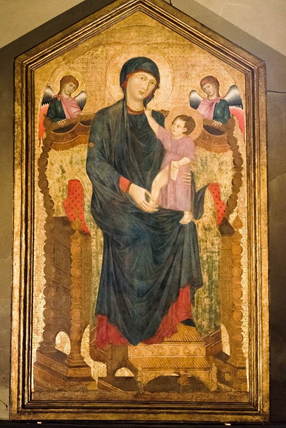The Maestà di Santa Maria dei Servi, dated between 1280 and 1285, is one of the most famous paintings by Cimabue (c. 1240 – 1302) preserved in the church of the same name in Bologna. It is a tempera and gold painting on panel that is related to the tradition of Byzantine iconography in Italian art and depicts the Madonna and Child placed between two angels leaning on the shoulder.

In this work, like many other sacred art paintings of the late Middle Ages by artists such as, Giotto, Duccio di Buoninsegna and Pietro Lorenzetti, gilding is a dominant part because it symbolises royalty and devotion to God. Since gilding was generally achieved by using gold leaf, it was not explainable why the Majesty had darkened considerably over time. Thanks to a research team led by the Institute of Chemical Science and Technology ‘Giulio Natta’ (Scitec) and the University of Bologna, the phenomenon responsible for the darkening was investigated using analytical chemistry techniques and the results published in the Journal of Analytical Atomic Spectometry.
During the diagnosis carried out for the restoration of the panel, the doubt that the dark parts of the work were unintentional led the researchers to take samples and analyse them. The samples were studied both through micro-analysis in the laboratory with vibrational microspectroscopy and with the ESRF synchrotron, located in the French city of Grenoble, using X-ray sources, showing that the main causes of the painting’s degradation are humidity and exposure to light.
From these investigations it was discovered that Cimabue, like other artists of the time used, instead of the very expensive gold, a mixture of orpiment powder, a yellow pigment of arsenic sulphide (As2S3) very similar to gold, and metallic silver. Synchrotron analysis proved that the cause of the browning is the formation of silver sulphide (Ag2S), a black compound commonly known to be responsible for the blackening of silver jewellery. Chemically, the reaction of orpiment with metallic silver occurs with the formation of silver sulphide and arsenic oxides (watch the video lecture on redox balancing) and is favoured by exposure of the work to moisture. However, researchers have ascertained that darkening also increases or with exposure to light, which, moreover, leads to the formation of further whitish-looking chemical compounds, sulphides and arsenates, which contribute to the degradation of the painting.
This paved the way for the correct conservation of paintings that have the same painting technique and are therefore affected by the same type of degradation as Cimabue’s Maestà: it is now known that works must be kept at a relative humidity of no more than 30% and that lighting must be adequate for painting materials that are known to be sensitive to light.
ACTIVITY: 1. Explain why if Cimabue had used gold leaf, his work would not have darkened. What property of gold makes it so valuable and used in jewellery? 2. Write down and balance the reaction through which the pigments in the work darken. What type of reaction is it?
